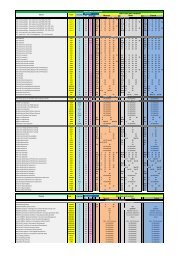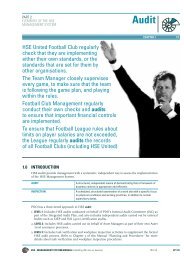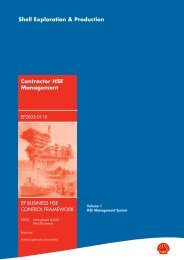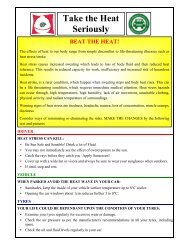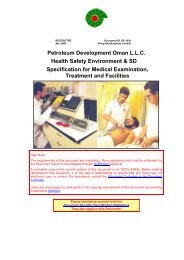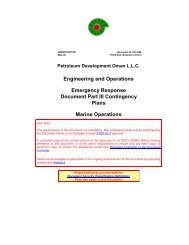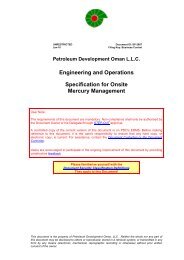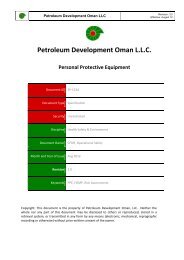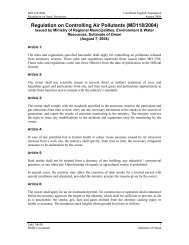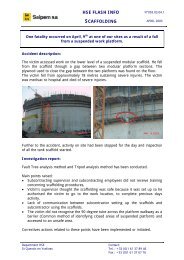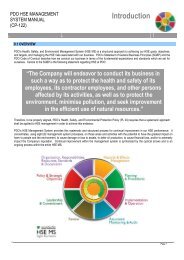Estate Service Asset - PDO
Estate Service Asset - PDO
Estate Service Asset - PDO
Create successful ePaper yourself
Turn your PDF publications into a flip-book with our unique Google optimized e-Paper software.
Petroleum Development Oman<br />
<strong>Estate</strong> <strong>Service</strong>s <strong>Asset</strong><br />
Environmental Assessment<br />
2002 Review and Update<br />
minimised through enhanced maintenance programs. There shall be no significant<br />
visible emissions of fugitive dust.<br />
(c) No smoke emitted shall be as dark or darker than shade 1 on the Ringlemann scale<br />
(equivalent to 20% opacity).<br />
(d) No odorous substances shall be emitted to the environment that are recognisable at<br />
residences for more than 150 hours per year.<br />
(e) CFCs, HCFCs or HFCs shall not be knowingly vented to the atmosphere. They<br />
shall be recovered and re-used during servicing and maintenance. No equipment<br />
or product containing CFCs shall be selected for purchase or lease. Further, no<br />
equipment or product containing HCFCs shall be selected for purchase or lease,<br />
unless no alternatives are available in the market.<br />
(f) There shall be no halon releases to the atmosphere for maintenance, testing or any<br />
other purposes. Halon releases are permitted under emergency situations only. No<br />
new halon fire fighting systems in new projects shall be purchased, and no virgin<br />
halons shall be used for recharging any existing halon fire fighting systems in use.<br />
2.4.2 Ambient Air Quality<br />
Presently, there are no Omani standards for ambient air quality. In their absence,<br />
MRME&WR recommends the use of United States Environmental Protection<br />
Agency's (USEPA) national ambient air quality (NAAQ) standards. <strong>PDO</strong> uses World<br />
Health Organisation (WHO) - European Union (EU) and Netherlands standards,<br />
which are more stringent than USEPA’s NAAQ standards. <strong>PDO</strong>’s ambient air quality<br />
standards are given as both limit values and guide values. The “limit values” are the<br />
maximum permissible concentrations in the ambient air, which if exceeded will result<br />
in non-compliance. The “guide values” are the desirable upper limits. <strong>PDO</strong>'s ambient<br />
air quality standards are given in Table 2.5 below.<br />
Parameter<br />
Oxides of nitrogen as NO 2<br />
Sulphur dioxide<br />
Hydrogen sulphide<br />
Carbon monoxide<br />
Table 2.5: Ambient Air Quality Standards<br />
Averaging<br />
Period<br />
1 hour<br />
4 hour<br />
24 hour<br />
1 year<br />
10 minutes<br />
1 hour<br />
24 hours<br />
1 year<br />
30 minutes<br />
24 hours<br />
1 hour<br />
8 hour<br />
Limit Value<br />
(µg/m 3 )<br />
400<br />
-<br />
150<br />
-<br />
500<br />
350<br />
125<br />
50<br />
-<br />
150<br />
40000<br />
6000<br />
Guide Value<br />
(µg/m 3 )<br />
-<br />
95<br />
-<br />
30<br />
-<br />
-<br />
125<br />
30<br />
7<br />
-<br />
-<br />
-<br />
©HMR Environmental Engineering Consultants C2- 4<br />
Oman’s Environmental Consultancy<br />
HMR\1501\<strong>Estate</strong> <strong>Service</strong>



